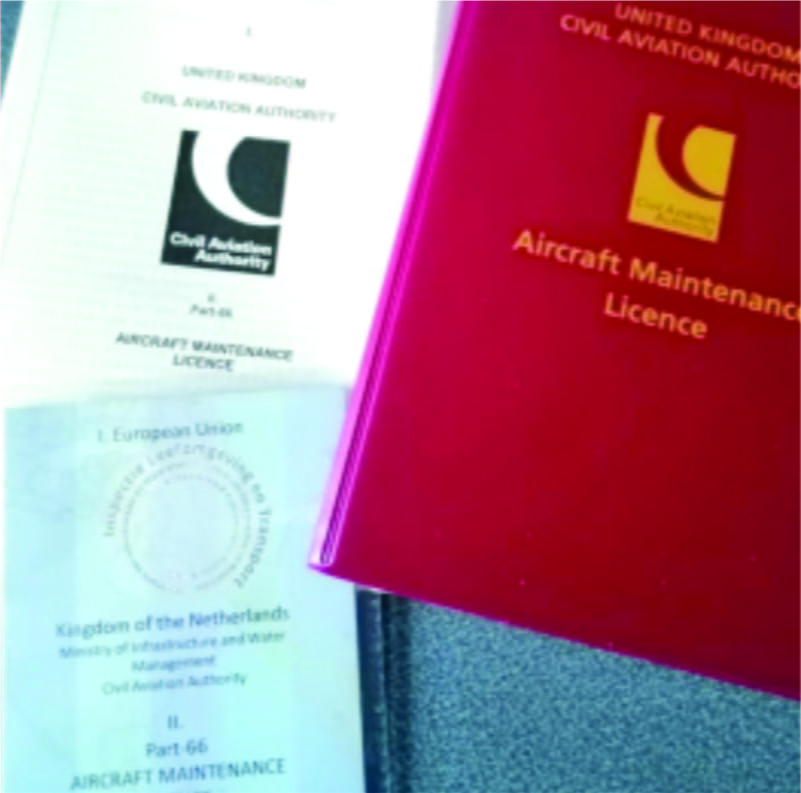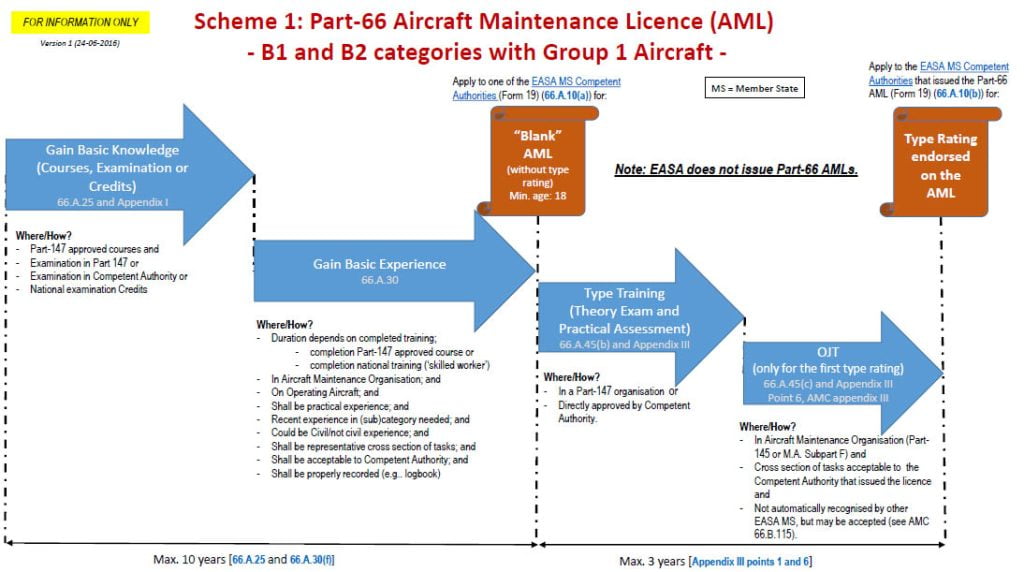An aircraft is a complex machine which is developed and manufactured involving mechanical, electronic and instrumentation systems. To keep an aircraft in an airworthy condition, it requires a team of highly skilled and knowledgeable Aircraft Maintenance Engineers (AME) to keep them afloat. These AME’s undergo a high level of quality training as stipulated by the EASA (EASA full form is European Union Aviation Safety Agency) to become a certified AME EASA license holder.

To clarify the meaning of EASA, it is an agency which functions under the European Parliament to ensure the synchronised aviation standards for air safety and is developed for the member states of the European Union. To ensure its global acceptance, the agency has made bilateral agreements with various Governments globally for mutual cooperation in the aviation safety standards.
The EASA certification technical training programs approved by the agency for the aircraft maintenance includes multiple category levels depending upon the aircraft structure and the installed engine. The EASA courses approved to be carried out in the aircraft maintenance training organisation or the EASA Part 147 organisation are namely
- Category A (Line maintenance Mechanical)
- Category B1 (Mechanical stream divided into 4 sub-categories namely B1.1, B1.2, B1.3 & B1.4 for heavy and light aircraft)
- Category B2 (Avionics stream)
- Category C (Heavy maintenance)
- Category L (Sailplanes, Hot air balloons)
AME EASA License
The aircraft maintenance license issued by EASA in aviation is the most sought after and reputed as compared to any Aircraft Maintenance License or the AML issued by National Aviation Authorities globally. For the sake of authorization issuance to work on the European registered aircraft located in Europe or any third world countries, holding an EASA License is a must to exercise the aircraft maintenance privileges. EASA AME License is the most recognised and accepted worldwide in all the developed and developing countries. To name a few global airlines like Lufthansa (Germany), Air France (France), KLM (The Netherlands), British Airways (United Kingdom), Qantas (Australia), Singapore Airlines (Singapore), Emirates & Etihad (U.A.E) employ EASA Part 66 license holders to carry out their aircraft fleet maintenance.
EASA AME (Aircraft Maintenance Engineering) Duration

EASA courses approved for aircraft maintenance are driven by the necessity of the type of task to be performed on an aircraft. These belong to the Mechanical stream or EASA B license (Cat B1 for Airframe, Power plant, Aerodynamics and System) and Avionics stream (Cat B2 for Electrical, Electronics, Instrument and Radio Navigation). The training programs pertaining to EASA Category A License are focussed on Line or Transit maintenance. The duration of the training program is variable. For Category A, the regulated EASA course minimum training duration is stipulated as 800 hours which includes theory as well as practical elements of skill and knowledge training. For higher level training programs such as EASA Category B1 or B2, the regulated minimum EASA course training duration is stipulated as 2400 hours which includes theory as well as practical elements of skill and knowledge training.
The theoretical elements training includes knowledge delivery behind the aircraft aerodynamics, structure and employed systems. As it takes a combination of mechanical and avionics systems to make the complex flying machinery to operate, exposure of hands on tasks to be performed on an aircraft and the associated components becomes a must in order to build up skill levels for enhancing the eligibility for the grant of EASA certification.
AME (Aircraft Maintenance Engineering) EASA Eligibility Requirements
The regulatory guidelines given for the EASA license requirements (eligibility criteria) for the enrolment in the EASA approved AME colleges in India are as follows
- Candidates minimum age by the time of issuance of license is 18 years and the minimum age for the admission in EASA AME training program 14 years.
- Candidate must be medically fit with no colour blindness.
- Candidates from any stream may enroll for admission (Science, Arts, Humanities, Commerce).
- Candidates must possess Government issued Photo ID card for the issuance of Temporary Airport Entry Passes.
Admission Process in AME EASA
For enrollment in EASA approved AME colleges in India, a candidate must exhibit a minimum level of understanding by undergoing an aptitude test. These exams are organised by the IIA CET every year in the month of April-May. As english is the internationally accepted language in aviation, candidates are required to demonstrate minimum band Level 4 or above of International English Language Testing System. For the meritorious students (scoring distinction and above), admission in the EASA courses becomes simple.
The eligible candidates are then invited for the final counselling and reporting on which they are required to submit
- Matric certificate (Class 10th certificate for date of birth proof)
- Intermediate school certificate (Class 12th certificate for evidence of electives & passing result) School leaving certificate
- Medical certificate issued by registered Medical practitioner (Minimum M.B.B.S)
- Copy of Govt. issued photo ID card (Adhaar or Passport copy)
Once all the documentation procedures are covered, the candidates are good to go for the training in the selected category as per EASA License requirements.
AME EASA Course Fees
The EASA AME License courses are on the higher side compared to the aircraft maintenance courses offered by the National Aviation Authorities. This is due to intensive training programs and upkeep of high examination and quality standards which are to be demonstrated by the EASA approved AME colleges in India. The cost of training depends upon the EASA license requirements. For the different approved Categories and subcategories the costing is fixed. Within the European Union, the average cost of the EASA Certification courses in Cat B ranges from US Dollars $24,000 to $40,000 for 2 years basic training duration. The costing for the EASA Part 66 License training program in India ranges from Rupees INR 1.2 million to 2.0 million. This costing is variable for the offered training programs due to tie-ups and charges incurred in the practical training sessions with the contracted airline partners.
AME License (EASA) Core Courses
The course associated with the EASA in aviation safety trains a candidate to exercise their privilege as an aircraft maintenance engineer. These EASA courses are differentiated as Mechanical (Cat B1) or Avionics (Cat B2) divisions with authorization limitation at different levels to carry out task based operations for the aircraft maintenance. As the aircraft airframe and systems are mainly mechanically designed, there is more requirement of the EASA Cat B license holders compared to Cat A. The components and equipment on an aircraft are maintained periodically and this requires services of the highly qualified staff to carry out base maintenance activities at the EASA approved maintenance organisations.
Skillset Required for AME EASA Course
EASA license requirements mainly command three key elements:
- Skill
- Knowledge
- Attitude
All of the above can be gained by attending organised training at the EASA approved AME colleges in India. The primary objective of attending the organised and approved EASA course training is to gather a specific knowledge level of information which enables one to work with higher level of proficiency whilst ascertaining safety and quality standards for the given aircraft maintenance task. The information of the tool, follow up of relevant manuals, associated consumables with precautions and safety procedures in place is provided to the students during the intended training duration. The practical performance sharpens the skill set of the trainees which are developed by hands-on practical task performance. The working environment and culture define the standard of the maintenance organisation. A good organisation focuses on attitude development towards the job performance as it not only enhances their productivity but also boosts employees morale.
EASA Approved AME Institute Under IIA Group
Indian Institute of Aeronautics is the oldest Aircraft Maintenance training organisation in India. It was approved in 1982 by the DGCA, Govt of India to impart aircraft maintenance training. Over the period of time with growth in aviation, the institution applied and received an EASA Part 147 approval status in India. The long history of the organisation bulgeons its reputation in the domestic and international aviation industry. The organisation is approved to conduct EASA Part 66 training and examination privileges at its approved location based at New Delhi, India.
AME EASA LicenseJobs and Career Opportunity
EASA license holders are accepted globally. This is owing to their high training and knowledge assessment through EASA Part 66 module examination standards. The EASA license holders are paid high salaries and high positions within a maintenance organisation. With the disruption of demand and supply after the pandemic, the scarcity of EASA license in India is creating a big buzz to feed the upcoming manpower shortage to meet the airline operators requirements.
Top Recruiters for AME EASA License Holder
EASA as an agency holds bilateral agreements with various Governments globally. This allows EASA license holders to exercise their EASA certification privileges not only in the European Union but at other avenues where the bilateral agreement exists. To name such a few countries along with 29 European Union member countries, Singapore, U.A.E, Australia, South Korea, Malaysia, Thailand, Kuwait, United States of America, Canada, Brazil, and many more countries accept EASA Part 66 license holders.
EASA AME Aircraft Maintenance Engineering FAQ’s
What is the meaning of EASA?
EASA stands for European Union Aviation Safety Agency. It is the aviation watchdog of the European Union whose purpose is to synchronise and promote aviation safety.
How many modules are in the EASA Course?
List of modules vary with the applied category of training & examination.
For Cat A: 11 modules
For Cat B1.1: 13 modules
For Cat B2: 12 modulesIs the EASA course tough?
Any training is tough if one lacks skill and knowledge to demonstrate. The organised EASA course training ascertains one to keep themselves abreast with the current information levels and right attitude to pass the module examinations and serve the aviation industry.
How can I get an EASA license in India?
To get an EASA license in India, you need to attend organised EASA Part 66 basic training and clear all the module exams pertaining to the applied category. After this a candidate needs to have 2 years of actual maintenance experience in Aircraft MAintenance Organisation where all the records of the tasks performed are entered in the candidates logbook verified by a senior supervising staff. The record of Training, examinations and experience is then sent to the European Union National Aviation Authority which after verification issues the EASA Part 66 Aircraft Maintenance License.
What countries fall under EASA?
There are 29 countries which are part of the European Union. These countries are Austria, Belgium, Bulgaria, Croatia, Republic of Cyprus, Czech Republic, Denmark, Estonia, Finland, France, Germany, Greece, Hungary, Ireland, Italy, Latvia, Lithuania, Luxembourg, Malta, Netherlands, Poland, Portugal, Romania, Slovakia, Slovenia, Spain and Sweden.
What is EASA training?
EASA training prepares a candidate to work in the field of aviation safety. This provides different levels of skill and skills to the candidate and make them employable to serve and work for making the skies safer.
Is EASA license valid in India?
There are many organisations in India which are approved by EASA under maintenance training organisation tag. To name a few Air India Engineering services Limited, GMR Aero Tech, Airworks, Cochin International Airport Limited, Horizon Aerospace to name a few. These organisations need to employ EASA certified staff to work and maintain the aircraft components and systems as per their authorisation. As long as EASA approved maintenance organisations remain in existence, the requirement for the EASA license holders will remain in the domestic aviation sector.
How long are EASA modules valid?
EASA modules are valid for adoration of 10 years from the very date of passing the first module examinations. If all the module examinations with reference to the relevant category are not cleared within the stipulated duration, the previously passed examinations become null and void.
